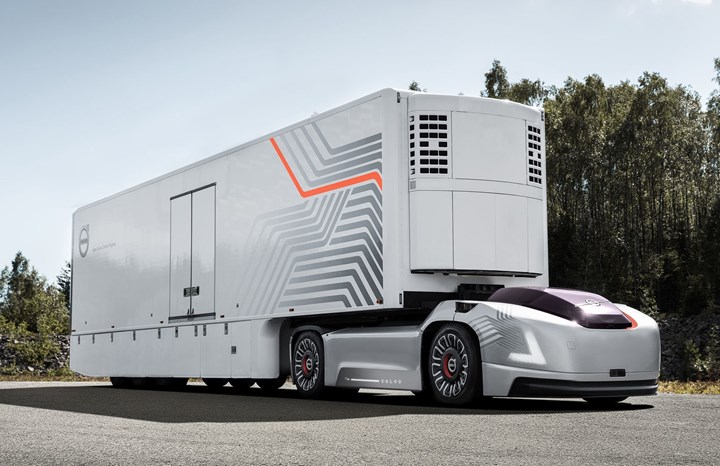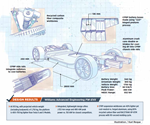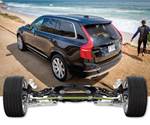Volvo's autonomous Vera transport vehicle uses composites
Cabless, fully electric development vehicle heralds future for short-distance autonomous transport.
Vera is a cabless, driverless truck described by Mikael Karlsson, vice president of Autonomous Solutions at Volvo Trucks, as “a complement to our current offering … still under development”. Its flat design brings to mind that of Williams Advanced Engineering’s FW-EVX electric vehicle platform, and while Vera is similarly battery-powered, it uniquely incorporates a fifth wheel coupling for hauling trailers or containers. Though currently its chassis does not use composites, its body components do. Volvo has been a leader in composites, adopting glass fiber-reinforced polyurethane rear axle leaf springs for its Scalable Product Architecture (SPA) platform used for the S60, S90, V60, V90 and XC60 models. Volvo’s performance brand, Polestar, meanwhile, will soon begin producing the Polestar 1, featuring a carbon fiber composite body.

Volvo unveiled Vera in Sep 2018. According to Volvo’s press releases at that time, Vera’s body was designed to emphasize its functionality. LED lights and more than 30 different sensors have been placed to fulfill functional requirements while also blending into the clean design. Colours were chosen to make Vera appear modern, urban, friendly and technical. The clean and simple silver body makes the vehicle appear lighter, while black denotes the technical areas of the vehicle, such as its “brain” in the front.
In developing Vera, Volvo’s Autonomous Solutions group began with customer needs to reduce costs and then explored possible solutions offered by automation, connectivity and electromobility. Vera is a fully electric, autonomous vehicle designed to integrate into more complex logistics systems.
Its first job will be transporting containers from the port of Gothenburg, Sweden to a nearby logistics center for Swedish transport company DFDS. Though it will travel along public roads, its speed will not exceed 40 km (25 miles) per hour, and the trucks will be monitored by operators in a control room. The goal is a connected system of several Vera vehicles monitored by a single control center to enable a seamless and constant flow responsive to demands for greater efficiency, flexibility and sustainability. The collaboration with DFDS is a first step towards implementing Vera in real transport assignments on pre-defined public roads in an industrial area.

According to Karlsson, the aim of this first implementation is to further develop Vera’s potential for other similar operations, namely repetitive assignments in logistics centers, factories and ports. Vera will then expand into other applications which require repetitive flows over short distances. “Vera is not intended to be a solution for everyone, everywhere,” he cautions. “It is a solution that we will adapt and tailor from user to user, depending on their unique needs.”
Read more about Vera: www.volvotrucks.com/vera
Related Content
-
Infinite Composites: Type V tanks for space, hydrogen, automotive and more
After a decade of proving its linerless, weight-saving composite tanks with NASA and more than 30 aerospace companies, this CryoSphere pioneer is scaling for growth in commercial space and sustainable transportation on Earth.
-
Jeep all-composite roof receivers achieve steel performance at low mass
Ultrashort carbon fiber/PPA replaces steel on rooftop brackets to hold Jeep soft tops, hardtops.
-
McLaren celebrates 10 years of the McLaren P1 hybrid hypercar
Lightweight carbon fiber construction, Formula 1-inspired aerodynamics and high-performance hybrid powertrain technologies hallmark this hybrid vehicle, serve as a springboard for new race cars.














.jpg;maxWidth=300;quality=90)
